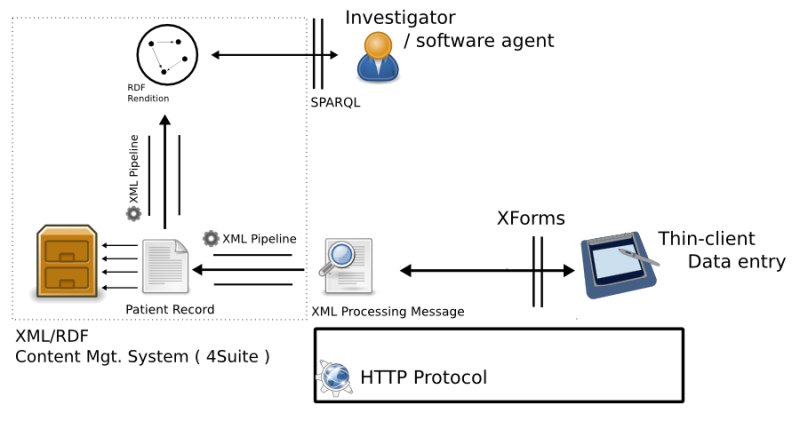Exploring Validation in an End-to-end XML Architecture
Chimezie Ogbuji
John L. Clark
Cleveland Clinic Foundation
Our niche
Clinical outcomes research
Distributed, web-based data entry
Patient records in XML
Repurposing
Ease of inspection and "hacking"
Conversion to RDF for merging, inference, and querying
Example query: "Patients who underwent an aortic or mitral valve repair or replacement at CCF for endocarditis between 1990 and 2006."
SemanticDB
Disclaimers:
- There will be pointy brackets
- All namespace prefixes map to the URIs "that you would expect"
- I use the term "XForm" to indicate a XForms instance document
The flow
Edit patient event or patient metadata (XForms in XHTML)
"REST", "POX", and XML Processing
Commit information to the patient record (HTTP → XSLT filter → XUpdate → save to 4Suite XML CMS)
Generate and store RDF
Query RDF (SPARQL)
Content management "patterns"
Patient-focused ⇒ “process” the XML
Cohort-focused ⇒ “investigate” a collection of patient RDF graphs
The flow (diagram)

Why validate?
Early error discovery and correction
Price for error discovery grows with the "distance travelled"
Error discovery may happen after a critical event
High-value (high integrity) data
Instant user feedback
Where to validate?

As close to the user as possible
Web based system
XForms - user editing XML directly
Validate in the form, in the browser
Where to validate? (ETL gate)

ETL: Extract, transform, load (Data warehousing)
Between data sources
Conversion from deprecated RDBMs store to custom XML serialization
Conversion from custom XML to RDF
Validation and XForms
Model Item Properties (MIPs)
readonly,relevant,calculate,p3ptypetyperequiredconstraint☆
The
xf:bindelementThe
:valid,:invalid,:required, and:optionalCSS pseudo-classesThe
validateattribute on thexf:submissionelement
View source - XForms
From the example:
The constraint binding:
<xf:bind nodeset="date" constraint="translate(substring(., 1, 10), 'T:-', '') <= translate(substring(now(), 1, 10), 'T:-', '')"/>The form control:
<xf:input incremental="true" ref="date"/>CSS:
:invalid:after { content: "\a0\2716 " }
Observations of XForms validation
Boolean validation
Is a value valid or not?
No information about why a value might be invalid
Directly architected on XPath context + XPath boolean expressions
Enter Schematron
Intro to basic Schematron
Example rule:
<sch:rule context="date"> <sch:assert test="translate(substring(., 1, 10), 'T:-', '') <= translate(substring(now(), 1, 10), 'T:-', '')" >The date must not be in the future.</sch:assert> </sch:rule>Wait, where have we seen this before?
Now with constraint descriptions!
now()is problematic
XForms + Schematron?
Not directly
Associate a Schematron schema with an XForm
Transform XForm to include assertions from schema
Submit to validation service that uses same schema
Get results in XML!
Can XForms process submission results in XML?
What we do - the setup
One "interesting entity" per XML file
Set of high-level chunks of the XML file
Need for some sort of primary key notion
Used to allow editing of chunks instead of the entire file (using XUpdate for merging)
Set of (possibly overlapping) views into potential chunks
Each view corresponds to an XForm
Describe set of XForms using a slightly abstracted vocabulary (called UIP)
Each form description can optionally contain a Schematron schema
The setup: Diagram

What we do - the process
Use XSLT to "compile" an XForm per view
Compilation transforms inline Schematron into "equivalent"
xf:bindsCompilation "extracts" inline Schematron
Salt XForms instance data with "state" information
Serve and enjoy
In the future: abstract aspects of Schematron for better XForms integration
The rest: Schematron critique
Flat rule space
Issues based on the (XSLT) implementation:
Contexts must be mutually exclusive
Lacking useful metadata (hint:
titleonrules, other documentation)XPath function portability
The rest: XForms critique
MIPs should (optionally) propagate up the DOM
Multiple MIPs per node?
Need for variables
XPath function portability
- Variables - do you remember trying to read that
constraintexpression?